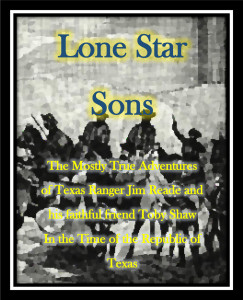 (This is part two, of the next Jim Reade – Toby Shaw adventure. Part one is here. Jim and Toby have been set to assist three agents of foreign powers who have come to Bexar, looking for something hidden away in a long-closed house, by a long-dead General with a slippery reputation. The third part is almost finished, and will be posted in a few days.)
(This is part two, of the next Jim Reade – Toby Shaw adventure. Part one is here. Jim and Toby have been set to assist three agents of foreign powers who have come to Bexar, looking for something hidden away in a long-closed house, by a long-dead General with a slippery reputation. The third part is almost finished, and will be posted in a few days.)
“As you and Captain Hays may already have guessed, my real and my feigned purpose both have to do with the late General Wilkinson’s house,” Albert Biddle explained, as soon as they had strolled beyond the edge of the crowd and the reach of Bernard Vibart-Jones’ mellifluous voice.
“Something is hidden within; documents or artifacts of considerable value?” Jim ventured and Biddle nodded. “Do you have any idea what we – you – are looking for? Something large, or small – papers don’t take up much space. If the house is like the other old Spanish houses of Bexar, there will not be much in the way of furniture.”
“Documents and letters,” Biddle affirmed. “The old man was a distant relative of mine by marriage. He died at a good old age, which perfectly astounded those who knew him best. Never won a battle or lost a court-martial, died rich, and in bed. It’s been suspected for years that he was blackmailing … certain people and a government or two, with whom he associated over the years, by holding on to proof of embarrassing peccadillos.”
“Certain people?” Jim’s eyebrows lifted. “Such as?” When Biddle replied with a short list of names – men of an older generation, all well-famed and of good repute – Jim whistled in astonishment. “Yes… I can see the worth of ensuring his silence.”
“It’s not just the men,” Biddle said unhappily. “It’s the good name of the nation, too.”
“Likely more than one nation,” Jim observed – Ah, that had surprised Biddle, at least momentarily, but then Biddle nodded.
“Credible,” he murmured thoughtfully. “The old general spread his nets very wide indeed; how many nations, then? Or would you be indiscrete in telling me?”
“No,” Jim answered, deciding to put all his cards on the table. “There are two other men making inquiries; an Englishman and a Spaniard. Captain Hays has given me wide discretion in this matter … for reasons of diplomacy, my government desires that all three of you find whatever it is that you are looking for in the Casa Wilkinson, do whatever you wish with it, and leave Bexar quietly and without causing an international ruction. That being understood, I will help you as best I can. Deal?”
“Deal,” Biddle answered. “I must admit that you Texians get down to brass tacks faster than practically any other Southren gentlemen I have ever dealt with. It’s quite refreshing.”
“It saves time. I still don’t quite grasp – why all the interest now?”
“Because everyone else is interested,” Biddle answered; he looked thoughtfully at Jim. “I did procure the keys to the Casa, for a brief inspection upon my arrival. The caretaker took them back almost at once, and has not permitted me access since; a most unpromising prospect for a search – almost no furniture at all, only bare walls and floors.”
“A caretaker?” Jim took a moment to accept that intelligence. “I hardly think any care of the place has been taken at all. Who is this assiduous caretaker – I was not given that information,” he added hastily.
“A great lump of a muleteer named Gomez, who lives in the house next to it. It seems that his aged grandmother was once the housekeeper there. Gomez has taken himself off to parts unknown, likely taking the only key with him.”
“I have sent a scout to look at the lay of the land,” Jim answered. “He speaks Spanish well – he rooms with a local family when we are in Bexar. From the stories, it seems that someone else has been able to get inside and search. I’d like to know how they did it, if not with a key.” Jim snapped his fingers, struck with a sudden insight. “The Spaniard, Don Esteban Saldivar; Captain Hays told me that he is also a recent visitor curiously interested in the Casa, to the point of taking rooms with the Gomez family. If there is a common wall, I would bet that he has found a way through – and that Gomez has gone away in order to keep you out while Don Esteban searches at leisure. These places are made of unbaked mud brick covered in plaster. It would be a simple matter simply to tunnel through …” Jim found himself walking faster in his excitement. He and Biddle had now gone the length of the Plaza, past the brooding dome of San Fernando, and back towards where Soledad Street led into the plaza.
“Let us walk towards the Casa – and see what my trusty scout has found.”
Without haste, they strolled into the narrow canyon of Soledad Street, the walls of mud-brick and plastered cedar-log jacal-huts rising at either hand, as the sky darkened overhead. This was the old part of town, where most houses had been built as sturdy as fortresses, nearly windowless on the side looking onto the street – and those which did have windows were as heavily barred as if they a prison. Only now and again did the amber of a candle or lamp lit within them cast a glow into the street. Music from an out-of-tune piano floated in the evening air from one direction, from another the sound of a melancholy guitar. The darting shadows of swifts flashed briefly across the sky.
“It is very different from Hartford,” Albert Biddle mused. “Almost a foreign country – is a foreign country, indeed.”
“But home to me,” Jim answered. With a start, he realized that it was true; Bexar was the place that he always returned to over the last handful of years, between the wide-ranging assignments given to him by his captain; here were the colors brighter, the food tastier, the water clearer, the sun in the sky brighter and the stars in the night sky sparkling ever more brilliantly. They walked on a little way, picking their footing carefully through the ruts and puddles, and piles of horse-dung in the uncertain and erratic light. Even being in town foxed Jim’s night-vision abominably, and he was about to suggest to Biddle that it was too dark to really see the lay of the land around the crumbling Casa Wilkerson, when he was galvanized by a scream – a woman’s shrill and panicked scream from somewhere ahead. Heedless of puddles, horse-apples and other hazards, Jim ran towards the source, with Biddle following closely.
In the light-limned oblong of an opened door, a woman stood, crying out in Spanish; a body huddled at her feet just outside the door.
“What has happened?” Biddle demanded, as the woman continued – it sounded now as if her horror and distress had merged into indignant complaint.
“The poor fellow has been beaten,” Jim answered, “and left at her door – my god!” The light from within the house fell across the prostrate figure of Toby, groaning and covered with mud and blood. “It’s Mr. Shaw – the scout that I sent… I can only guess that he found something.” Jim knelt next to his friend and helped him to sit up. “Brother – what did you find? Who did this to you?”
“I didn’t see,” Toby answered indistinctly. He spat blood from his mouth. “Two men, I think. I thought I saw something in the shadows – I looked toward it, and someone hit me from behind.” He winced, squinting as if the light from the doorway hurt his eyes. “Then they took turns hitting me. James, I do not think that any bones were broken – I think they took it amiss that I was here…”
“Then that someone had better get damned used to it,” Jim answered. “Help me with him, Biddle – carefully! I’m gonna take it personal, now. I wonder …” He thought perhaps he should keep his supposition to himself, but Biddle shook his head and affirmed, “Couldn’t have been Vibart-Jones, he’s still on stage. And Senor Don Saldivar was still on the other side of the square when we walked into this street.”
“Either one of them may have hired their own ruffians to do the dirty work,” Jim answered, and unshipped his hesitant command of Spanish, “Senora, podemos entrar y tienden heridas de este hombre?”
“Si, si!” the woman answered, standing a little aside from the doorway, as the two of them guided Toby’s uncertain steps through it and into a small and cozy room, lit with a single lantern hung from a metal bracket over the cooking fireplace – the old-fashioned kind most often seen in the oldest houses in Bexar. In the warmest corner of the room, an elderly person lay propped upon a rough cot, so tiny and shriveled, so wrapped in layers of robes and blankets that it was difficult to tell with certainty if the person was a man or woman. The person’s eyes were milky and unfocused, without color at all, and a querulous voice called from the midst of the bundle. The woman of the house answered, in a voice which sounded at once soothing, but with an underlay of irritation. The elderly person sank back into their blankets, as if reassured, a shriveled turtle retreating to the cozy shelter of its shell.
“Senora Gomez,” Toby gasped, as Jim and Biddle hoisted him within the room and let him down before the fireplace. “I am glad for the hospitality…estoy agradecido por su hospitalidad…” he added.
“Agua caliente, por favor,” Jim demanded, before adding to his assistant. “We must wash those deep wounds immediately, lest they become putrid…”
Jim bent to this task, while Biddle and the woman of the house watched with interest – even moving to brew a tea of dried herbs over the fireplace.
“Willow-bark and sage,” Toby explained, although it obviously pained him to talk. Presently the elderly person ventured a querulous remark and Toby drew in his breath with a hiss, before responding in courteous Spanish.
“It is Dona Adeliza,” he explained to Jim and Albert Biddle. “The Old One; she wants to know what is going on. I have told her. She is amused – for she remembers the old General very well. He was a … disruptor of peace and quiet when alive, so of course he would do the same when dead. A restless and unquiet spirit – she says that we should ask the priest to come from San Fernando and do a blessing in each room of his old house. But she thinks it should best be torn down, or made into a stable.”
Senora Gomez interjected a comment – which sounded like a chiding – and the old lady answered, as feisty as a very old sparrow.
Biddle chuckled, “Old as she must be and blind to boot, she doesn’t sound like she has ever missed much. Ask her – about Don Esteban Saldivar and why a rich Spaniard would take rooms here … go on. Ask her – maybe she has some knowledge of this matter.”
That question elicited a perfect fountain of indignant Spanish from Senora Gomez, as well as a witchy-sounding cackle of laughter from the old lady. “Todo lo que tenían que hacer era preguntarme!” she exclaimed. – All they had to do was ask me! – Dona Adeliza continued in much the same vein, of which Jim divined a few scraps of words, enough for a rough estimation of what the old lady was saying; “You silly fools! All they had to do was ask – silly men – the General, he had caused to build within the house a secret place for his most precious things. And I know where it is! I have known all this time!”
At their backs, the door to the outside suddenly swung open, admitting a gust of chill night air into the room and making the candle flicker wildly.




Recent Comments